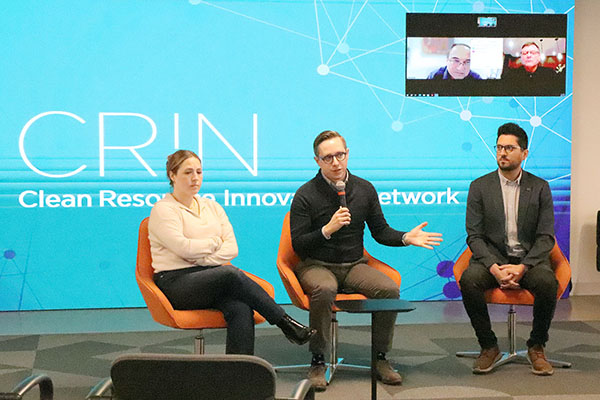Oct 29, 2024

Event Recap: CRIN October 29 Project Café
An inspiring series of Project Café events wrapped up on October 29 with five more innovators presenting their achievements to date on their CRIN-supported projects.
Zac Young, Co-Founder and COO of H2NanO Inc., shared details about their project Solar-Activated Accelerated Water Treatment for Oil Sands Mine Water.
Since 2022, the project has focused on the accelerated treatment of mine water in Canada’s oil sands.
Young explained the company’s SolarPass technology, a sunlight-activated catalyst that floats at the surface of the water.
“Instead of converting sunlight energy into electricity, we’re generating chemicals from the water itself,” he explained. “These chemicals go and break down the complex organic molecules that are in the water from the bitumen extraction process, and in so doing, it converts them to being more hydrophilic, which is a matter of saying that they don’t interact the same way with aquatic species, and that breakdown eventually mineralizes them, so that they are no longer present as potential contaminants in the water.”
Downstream of H2Nano’s technology, the company is also analyzing how it can integrate with other natural remediation systems such as wetlands to achieve treatment objectives.
Young said H2NanO continues to grow, with a focus on continuing to expand upon its successes in making water management more sustainable in the energy and mining sectors.
The company is looking for additional mining, energy, and utilities-scale pilot project partners.
Al Telmaderreie, CEO and Co-Founder of energy start-up Cnergreen, said his company uses innovative nanoparticle-based foam technology – which remains stable in harsh reservoir conditions - to help oil and gas companies improve their hydrocarbon extraction efficiency while storing more CO2 underground and reducing the carbon intensity.
ArmorFoam blocks short circuits, creates new pathways that produce more oil, and unlocks pore space for C02 storage.
With CRIN’s support, Cnergreen has launched multiple pilot projects. Its next steps include continuing the current pilots in addition to new pilots that are in progress and expanding to the U.S. and new applications. The company is looking for strategic partners to pilot their technology.
Katrina Stewart, Director of Biotechnology and Carbon Reduction with Cvictus, presented successes from the project Mannville Enhanced Hydrogen Recovery Project.
“Our project is to develop a clean hydrogen facility to produce low-cost, low-carbon hydrogen for the emerging hydrogen economy,” she said, noting it’s a first-of-its-kind commercial facility using Cvictus’ novel patented technology.
That technology is a combination of two commercially successful technologies, underground coal gasification and CCS.
Stewart said most recent calculations show the technology is leading to even lower than anticipated carbon intensity.
“This is really exciting to move through the process and get more final numbers,” she said. “We’re still anticipating to be very cost-competitive with traditional grey hydrogen.”
Another development is that Cvictus received a new patent in September.
“We’re really excited about the next few months and what this technology can bring to Alberta and to the world,” Stewart said.
Hyfold Technology Corp.’s Trent Hunter shared findings from the project Stationary Seismic Monitoring.
Hunter said Hyfold Technology was created to evaluate the potential for using plasma physics to generate acoustic waves to be used for seismic purposes.
“The value is that the production of plasma seismic does not generate any GHGs,” he said. “So, it’s a potentially very low carbon footprint project.”
Hyfold has done a lot of work on mobilizing the technology and demonstrating it in the field, it conducted eight customer-focused surveys, and it has one permanently installed project in southern Alberta.
“The project is now considered TRL 9 and/or commercial,” Hunter said.
Hyfold has successfully demonstrated the safe mobilization of the technology in the field, managed a transition from stationary monitoring to mobile surveys, and expanded its market. It is currently in the IP phase of its project.
Soheil Khiavi wrapped up the presentations by sharing details about the Hydron Energy project Waste to Fuel: Accelerating Commercialization of the Lowest Cost and Smallest Scale Novel Biogas-to-RNG Upgrading System.
“Hydron is a company that we started at the end of 2020, going after pre-combustion carbon capture…and the goal for this project was to do a demonstration,” Khiavi. “This project was focused on fuel testing and scale-up.”
Hydron’s disruptive clean fuel production unit operates under ambient conditions, upgrading biogas, syngas, and other mixed gas sources into biomethane or clean hydrogen. It has about half the cost of installation and operation compared to other technologies, 5 percent higher recovery, 80 per cent lower carbon footprint, and better scalability and mobility, according to analysis by a third party.
The company is actively working on scale-up and raising capital.